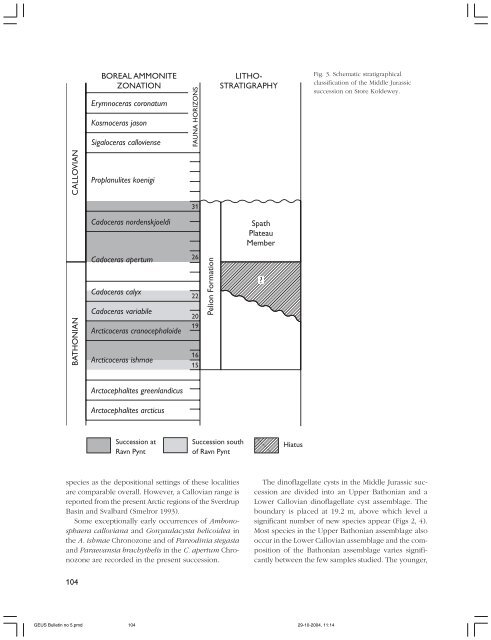GEUS Bulletin no 5.pmd
GEUS Bulletin no 5.pmd
GEUS Bulletin no 5.pmd
You also want an ePaper? Increase the reach of your titles
YUMPU automatically turns print PDFs into web optimized ePapers that Google loves.
BATHONIAN CALLOVIAN<br />
species as the depositional settings of these localities<br />
are comparable overall. However, a Callovian range is<br />
reported from the present Arctic regions of the Sverdrup<br />
Basin and Svalbard (Smelror 1993).<br />
Some exceptionally early occurrences of Ambo<strong>no</strong>sphaera<br />
calloviana and Gonyaulacysta helicoidea in<br />
the A. ishmae Chro<strong>no</strong>zone and of Pareodinia stegasta<br />
and Paraevansia brachythelis in the C. apertum Chro<strong>no</strong>zone<br />
are recorded in the present succession.<br />
104<br />
BOREAL AMMONITE<br />
ZONATION<br />
Erym<strong>no</strong>ceras coronatum<br />
Kosmoceras jason<br />
Sigaloceras calloviense<br />
Proplanulites koenigi<br />
Succession at<br />
Ravn Pynt<br />
Succession south<br />
of Ravn Pynt<br />
LITHO-<br />
STRATIGRAPHY<br />
Cadoceras <strong>no</strong>rdenskjoeldi Spath<br />
Plateau<br />
Member<br />
Cadoceras apertum<br />
Cadoceras calyx<br />
Cadoceras variabile<br />
Arcticoceras cra<strong>no</strong>cephaloide<br />
Arcticoceras ishmae<br />
Arctocephalites greenlandicus<br />
Arctocephalites arcticus<br />
FAUNA HORIZONS<br />
31<br />
26<br />
22<br />
20<br />
19<br />
16<br />
15<br />
Pelion Formation<br />
Hiatus<br />
<strong>GEUS</strong> <strong>Bulletin</strong> <strong>no</strong> <strong>5.pmd</strong> 104<br />
29-10-2004, 11:14<br />
?<br />
Fig. 3. Schematic stratigraphical<br />
classification of the Middle Jurassic<br />
succession on Store Koldewey.<br />
The di<strong>no</strong>flagellate cysts in the Middle Jurassic succession<br />
are divided into an Upper Bathonian and a<br />
Lower Callovian di<strong>no</strong>flagellate cyst assemblage. The<br />
boundary is placed at 19.2 m, above which level a<br />
significant number of new species appear (Figs 2, 4).<br />
Most species in the Upper Bathonian assemblage also<br />
occur in the Lower Callovian assemblage and the composition<br />
of the Bathonian assemblage varies significantly<br />
between the few samples studied. The younger,

















